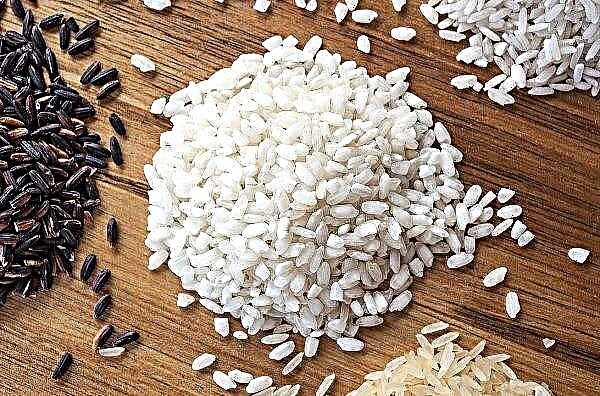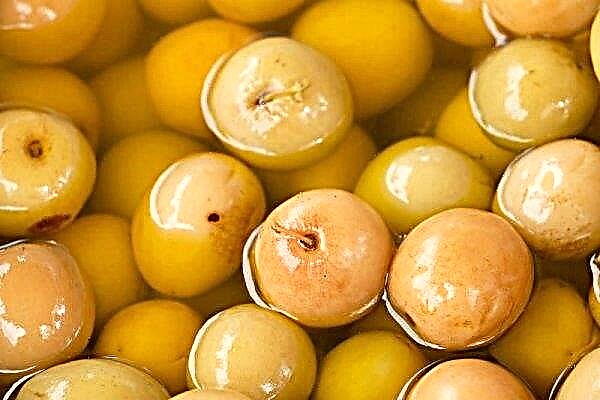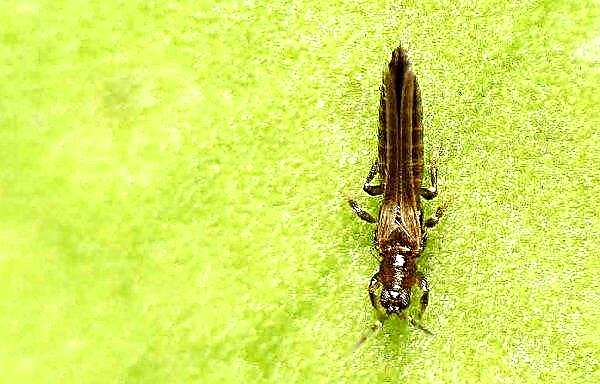Small-leaved ficus due to its high decorative qualities is a favorite plant grown in the home. Another important advantage of the culture is its unpretentiousness, unpretentiousness in care, simplicity and cheapness in cultivation. What else is able to please the ficus of flower growers and how to propagate it yourself, let's figure it out.
Botanical description of the plant
Small-leaved ficus, also known as Benjamin's ficus, is a perennial, evergreen shrub or tree that is a member of the Tutov family of the Ficus genus. The homeland of the plant is considered to be the countries of South Asia, the Philippines and Australia.
In nature, a tree can grow up to 8–10 m; in a house, its height rarely exceeds 1.5–2 m. The culture has a strong, thick trunk of gray color with small strokes on the surface.
Shoots are erect, leaves are oval in shape with an elongated nose, rather dense, with a shiny, glossy, radiant surface, without any pronounced sinewy. The color of the leaves ranges from light green to dark green. Ficus with variegated leaves are also found.
The plant blooms with small, inconspicuous flowers of yellow-green color. After flowering, small fruits are formed on the bush, presented in the form of round, slightly oblong berries up to 2 cm in diameter, red or orange.
Fruits called Siconia are inedible. Note that when growing a house in rare cases, the plant blooms and bears fruit.
There are a large number of varieties of ficus, which differ in leaf color and shape.
At home, few are cultivated:
Useful properties and harm
Ficus Benjamin small-leaved is not just a beautiful ornamental plant, it has healing properties and is used to treat some female ailments, in particular, uterine fibroids and fibriomas, mastopathy.
Did you know? To give ficus more decorativeness, very often three young plants are planted in one container, whose trunks are twisted into a pigtail or bundle. Over time, such structures become stiff, fused and form unique growths.
Popular beliefs say that growing a plant at home has several advantages, since it:
- returns the joy of life and gives peace of mind;
- gives a charge of vivacity, makes it easier to tolerate difficulties;
- contributes to the improvement of brain activity;
- increases working capacity;
- able to get rid of infertility if the flower is placed in the bedroom;
- can renew renewed passion in family relationships.
However, to maintain the "magical" power of the tree, he needs to provide quality care. As soon as the foliage withers, the healing properties of the bush disappear.
The shrub also has the unique ability to purify the air of harmful substances such as the evaporation of formaldehyde, benzene and phenol. In folk medicine, a decoction of leaves is used as an additional therapy for radiculitis, osteochondrosis, arthritis. Alcohol tincture lubricates warts, papillomas, wen.
Do not forget that ficus is a toxic plant and can cause allergic reactions. It secretes milky juice - latex, which can be manifested in sensitive people by negative reactions of the body - fever, suffocation, rashes, rhinitis. Such an allergy in most cases passes quickly, however, if there is a constant “irritant”, the disease can take a chronic form, which will not be easy to get rid of.
Such an allergy in most cases passes quickly, however, if there is a constant “irritant”, the disease can take a chronic form, which will not be easy to get rid of.
House growing conditions
Ficus Benjamin refers to unpretentious plants that can easily be grown in the home. When growing, you should especially carefully monitor the lighting, temperature and humidity.
Location
The flower prefers good, bright lighting, so it likes to “settle down” on the windowsills from the southeast or southwest side of the apartment. At the same time, the plant is sensitive to direct sunlight and can get burns, so it is better to darken it in hot weather.
Important! The color of the leaves and their variegation depend on the lighting, therefore, to preserve the color, the culture should be placed in well-lit places.
If the plant is far from a natural light source, then it needs to organize artificial lighting, for example, using fluorescent lamps. The optimal daylight hours for ficus is considered to be 10-12 hours.
In the summer, when the weather is hot, it is recommended to take the flower out into the fresh air, avoiding drafts and direct sunlight.
Temperature and humidity
One of the most important factors affecting plant health is room temperature. The most comfortable Benjamin flower feels at temperatures of +20 ... + 25 ° C in the summer and +16 ... + 20 ° C in the winter. At low temperatures, the growth of the crop is suspended, so even in winter its parameters should not decrease below + 16 ° C. It is not recommended to place the flower near heating appliances, as this can lead to yellowing of the leaves and their falling.
At low temperatures, the growth of the crop is suspended, so even in winter its parameters should not decrease below + 16 ° C. It is not recommended to place the flower near heating appliances, as this can lead to yellowing of the leaves and their falling.
Also, the plant reacts negatively to sudden changes in temperature and can completely discard the foliage.
For ficus, 70–75% are considered optimal humidity indicators, therefore it is very important to maintain the proper level in the room. Too low humidity contributes to the "inhibition" of flower growth, and too high - to decay of the root system.
To ensure the necessary level of humidity in the room, experts advise regularly spraying the foliage of the culture, systematically making a full bath for it, or placing a container with water, an artificial decorative fountain near the pot.
Home Care
Caring for Benjamin's ficus at home implies the implementation of basic rules, which include: timely watering, fertilizing, pruning, transplanting.
Watering
Ficus, as a native of hot countries, prefers plentiful, regular watering. But you should not overdo it with hydration, as this can lead to decay of the roots and discoloration of the foliage. A lack of moisture also negatively affects the condition of the flower, which can discard the leaves.
The optimal irrigation schemes are considered: in the summer - 2-3 times a week, in the winter - 1 time in 7-10 days.
The signal for irrigation is the drying of the soil layer by approximately 2.5–3 cm. Watering should be abundant, under the root, until the water flows out of the pan. Then the remaining water must be drained. Bottom watering directly into pallets is also practiced.
In winter, the amount of moisture should be reduced to 1-2 per month, but do not allow strong drying of the soil. Water intended for humidification should be settled at room temperature. Watering with cold water from the tap can lead to the death of the culture.
Top dressing
Experts recommend combining ficus watering with its top dressing, which the plant especially needs in spring and summer. As fertilizers, mineral and organic based products are excellent, which should be applied alternately, twice a week. After the onset of cold weather, the flower does not need to be fed. One-time fertilizer application within a month is allowed.
Top dressing should be added to irrigation water and moisten the flower in the traditional way. In order to improve the condition of the crown and activate its growth, it is allowed to feed the culture with special means, for example, Epin.
Crown formation
Ficus lends itself perfectly to shaping, so regular pruning will allow you to get a neat, beautiful and harmonious bush. Cut the plant in early spring, before the start of its active growth, once a year.
By cropping, you can form a flower of various shapes:
- spherical;
- multi-tiered;
- bushy.
Important! The age of the plant is reflected in the complexity of crown formation. The younger the ficus, the easier and easier it is to give it the desired shape.
When cutting branches, it is necessary to observe several important rules:
- it is impossible to break off branches, only their trimming is allowed;
- pruning is carried out with a sharp knife or secateurs, which are pre-treated;
- It is strictly forbidden to damage the crown;
- You cannot delete extra branches.
 Dry, too old, diseased branches fall under obligatory pruning. When forming a wide bush, the tops of the plant should be cut and pinched.
Dry, too old, diseased branches fall under obligatory pruning. When forming a wide bush, the tops of the plant should be cut and pinched.If the flower is frozen, dried up or sick, it can be resuscitated by cutting at the base, leaving only the stem 3-4 cm high. After a few months, with proper care, the plant will be able to completely renew itself and let out young shoots.
Transfer
Growing ficus at home does not do without a regular plant transplant. Over time, the root system grows, and the old capacity becomes too small. In such cases, a culture transplant is recommended. Benjamin's young flower needs a transplant every year, an adult (more than 5 years) - 1 time in 3-4 years.
Usually the event is held in the spring, combining with trimming ficus. The new pot should be 2-3 cm larger than the previous one. It is not recommended to select containers with a large diameter, since the plant activates the growth of the root system and slows down the development of foliage.
The ficus transplant procedure consists of several steps:
- at the bottom of the tank lay a drainage layer of expanded clay, small stones or pebbles;
- a small layer of soil mixture, which consists of: two parts of sod land and one part of sheet soil, peat and river sand, is filled up on top of the drainage;
- the bush is gently pulled from the old pot, inspect the root system. In the presence of sick, rotten or dry roots, they are removed, the sections are treated with chopped charcoal;
- the plant is planted in a container, sprinkled with a soil mixture, rammed a little.
 After transplanting, watering the culture is allowed only after 2 days. If the room is too hot or has a low level of humidity, spraying ficus leaves with a spray gun is allowed.
After transplanting, watering the culture is allowed only after 2 days. If the room is too hot or has a low level of humidity, spraying ficus leaves with a spray gun is allowed.Important! When choosing the soil for planting a bush, it should be remembered that too acidic soils are harmful to it. The most appropriate level of acidity is considered to be pH 5.5–5.6.
How to propagate at home
Only fully healthy, strong ficus can be propagated. A weakened and diseased plant will not be able to give strong offspring. There are several methods of home breeding: cuttings and using a leaf.
Cuttings. The most suitable time for reproduction is considered to be May-June, when the growth of young shoots is activated.
The cutting process takes place in several stages:
- The choice of cuttings. On the stem, choose a strong, strong shoot 10 cm long, with 3-4 knots, which are carefully cut at an angle with a sharp knife. All large leaves are removed on the handle, leaving only 3-4 leaves.
- Cleansing the cuttings. Milk juice is secreted at the cutting site at the cut, therefore it is impossible to root the shoot, you should wait until the end of the selection process. To do this, rinse the stalk under warm water and dry it with a towel or put it in a jar of water and change the water every 60 minutes for fresh. As soon as the juice ceases to stand out, the stalk is dried in air for 2-3 hours.
- Rooting. The prepared cuttings are placed in a container with clean, not cold water and placed in a well-lit, warm place.
The stalk will be able to quickly form roots with a high level of humidity, so it is recommended to cover the jar with the processes with a plastic film, which will create greenhouse conditions. From time to time it is necessary to monitor the cuttings, add water to the tank, change it to fresh. After 4–4.5 weeks, new roots will appear on the handle, which serve as a signal for transplanting the plant into a separate container.
After 4–4.5 weeks, new roots will appear on the handle, which serve as a signal for transplanting the plant into a separate container.
Reproduction by leaves. This method is more complex and lengthy, therefore, novice growers are used in rare cases. For propagation, leaves from the upper part of the ficus are selected. The leaves are cut so that they have several internodes.
Further reproduction is carried out according to the scheme:
- Leaves are planted in the soil specially designed for ficus, while the petiole must be higher than the soil level.
- The leaves are pre-twisted in the form of a tube, fixed with an elastic band and fixed with a small toothpick. The conditional peg is placed in such a way that it passes through the center of the folded sheet. Such events will give the petiole stability.
- After planting, the soil surface is moistened, and the container with seedlings is covered with a film.
- The containers are placed in a warm, well-lit place, periodically airing the sprouts.
After 30-40 days, the first leaves will form on the seedlings, which signals the successful rooting of ficus.
Did you know? Ficus has another informal name - a rubber tree, because the milk secreted by the tree is 15% rubber. For this reason, the plant is widely used in industrial and industrial fields.
Growing difficulties
Problems that may arise with the health of ficus, in most cases, are associated with non-compliance with the rules for caring for it. The fact that the plant is affected by ailments is signaled by its appearance:
The fact that the plant is affected by ailments is signaled by its appearance:
- falling leaves, the trunk becomes “naked” - a consequence of excessive waterlogging of the crop or the introduction of a large amount of fertilizer. In such cases, so that the flower of Benjamin stops dropping leaves, it should be transplanted into another substrate and carry out sanitary cleaning of the roots;
- the appearance of brown or yellow spots on the leaves - talks about the negative effects of direct sunlight on the plant or about too intense lighting;
- leaves wither, gradually fall off - the cause of this condition may be a lower air temperature, at which the growth of the culture slows down;
- leaves turn yellowgrow poorly - indicates that a lot or, conversely, little fertilizer was applied.
Important! It must be remembered that during the cut from the “wound” milky juice is released, which is poisonous, therefore, when pruning the branches, it is necessary to use personal protective equipment, for example, rubber gloves.
To find out the reason why the ficus small-leaved crumbles, it is necessary to conduct a visual inspection of the culture for the presence of parasites.
The plant may be affected:
- spider mite, the signs of which are also a white coating on the underside of the foliage;
- mealybug, which manifests itself in the form of white spots with a sticky surface on the foliage resembling cotton wool;
- scale, the action of which is expressed by brown spots and growths on the leaves.
 Effectively fight parasites will help modern insecticides with a wide spectrum of action. You can also get rid of pests using folk methods, in particular, wiping the leaves and stalk with a soap solution or tincture of garlic, diluted in water.
Effectively fight parasites will help modern insecticides with a wide spectrum of action. You can also get rid of pests using folk methods, in particular, wiping the leaves and stalk with a soap solution or tincture of garlic, diluted in water.Small-leaved ficus is a beautiful, original plant that will look harmoniously in any interior.In addition, it has a luxurious appearance and can be of great benefit, since it cleans the air well, saturates the room with oxygen, and the plant has a beneficial effect on the microclimate in the family.












